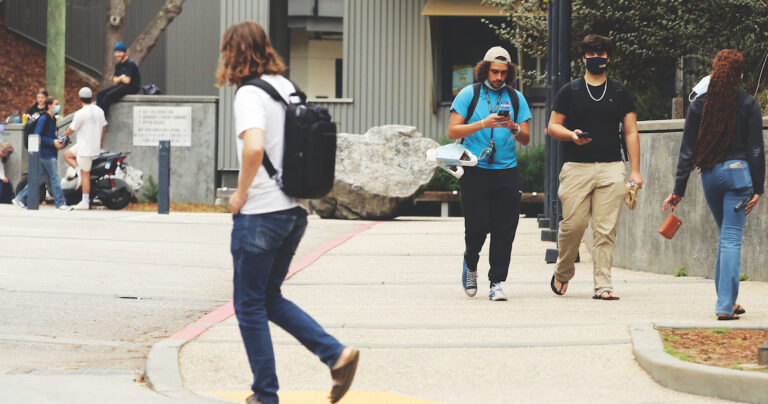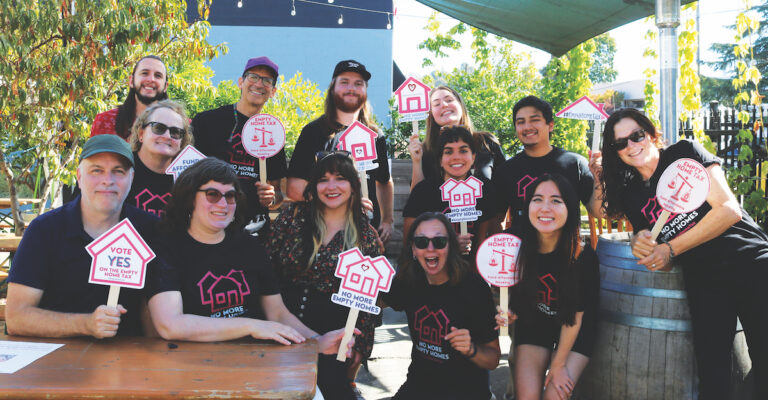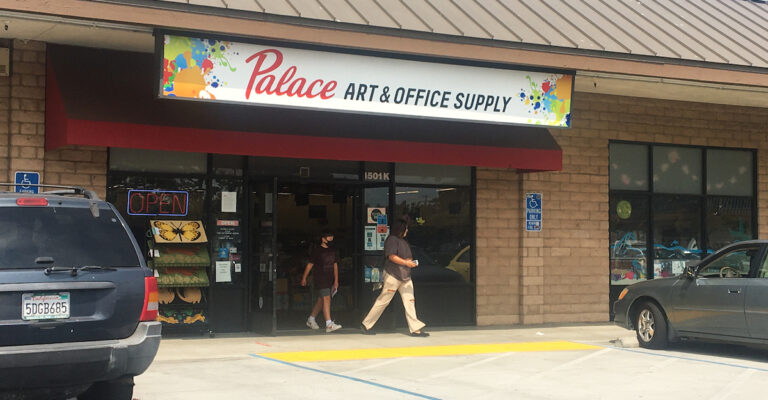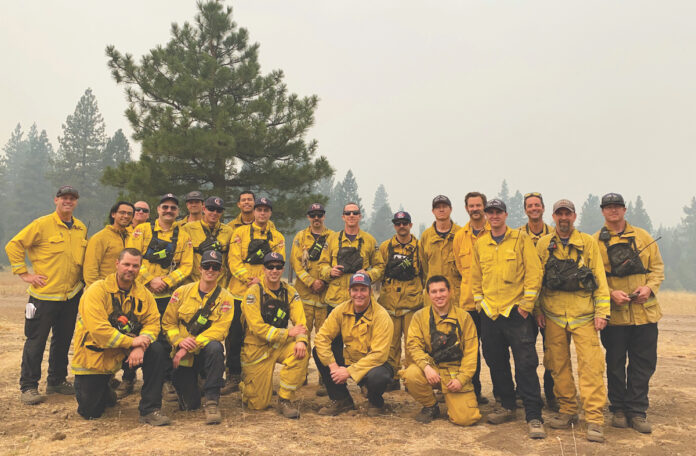After five years of rapid growth, our Santa Cruz Gives holiday campaign is doubling the number of local nonprofits we accepted to 80. Here’s a guide to the projects they will fund with your donations
Alzheimer’s Association
Big Idea for 2022: “Alzheimer’s Doesn’t Stop—Neither Do We.” More than 5,300 people in Santa Cruz County live with Alzheimer’s and other dementias, and another 8,000 loved ones and caregivers are impacted. All deserve reassurance they are not alone on their journey. The Alzheimer’s Association in Santa Cruz connects people with a community of support every step of the way. All services are free and offered in English and Spanish by phone, virtually, and in-person, including care consultations to help families anticipate and plan; support groups to connect with others who understand the journey; education on topics such as how to have dementia conversations, effective communications with those living with dementia, self-care for caregivers; healthy living for brain and body.
Arts Council Santa Cruz County
Big Idea for 2022: “Watsonville Movement for Arts and Culture.” Imagine a bustling, welcoming, and inclusive space for artists, arts organizations and the community in Watsonville. A place where we all belong, are rejuvenated and have fun through the arts. Our collective yearning for a space to create, experience joy and feel connected to ourselves and each other is palpable. Let’s build a home for the arts rooted in Watsonville’s rich cultural traditions, hopes and imagination.
BalanceSCC
Big Idea for 2022: “2022 Teacher Grant Fund.” Our Teacher Grant Fund grants more than $25,000 in supplies annually directly to local teachers and service providers for items they need but cannot afford. Typical items are Chromebooks, iPads, therapeutic chairs and swings, etc. We typically gift to approximately 60 local teachers/specialists who each work with 30-200+ students with unique needs each year. We raise the funds from the community to support this effort. We have also given free training to more than 100 local educators for school staff to help children learn constructive ways to handle crisis.
Big Brothers Big Sisters of Santa Cruz County
Big Idea for 2022: “Transgender Matching Program & LGBTQ+ Service Expansion.” Big Brothers Big Sisters began matching transgender youth throughout the county with volunteer transgender adult mentors in 2015. We will increase support to our mentors, matches and other agencies on LGBTQ+ matters through training, roundtables and enhanced match support and activities to address this underserved population. We work in close partnership with other agencies to implement a proven mentoring model, which serves as a national model.
Birchbark Foundation
Big Idea for 2022: “Love Heals.” When a pet has a health crisis with a good prognosis, the unique love of a family animal must never be lost simply due to cost. BirchBark will provide stability to vulnerable families faced with fixable, but unaffordable, urgent veterinary care. Our goal is to provide healing love and save the lives of 100 pets with Santa Cruz Gives donor funds. In addition, we help our veterinary partners, who often must euthanize pets and are extremely affected emotionally when clients do not have financial resources to save their animals’ lives.
Bird School
Big Idea for 2022: “Spreading our Wings.” Research clearly indicates that time spent connecting with nature significantly improves people’s mental and emotional well-being, which is seriously at risk for many young people today. The Bird School Project looks forward to expanding access to transformative pathways in birding, community leadership, field experiences and overall personal health and well-being for the students of Santa Cruz County. With your support, BSP strives to reach more students from minority and underrepresented backgrounds, providing resources and mentorship for them to become environmental changemakers. Our highly successful core program costs only $6 per student. Funds raised supplement the cost of our program for schools in Santa Cruz County, often making it free.
Boys and Girls Clubs of Santa Cruz County
Big Idea for 2022: “Power Hour + SMART Moves Programs.” Our clubhouse-wide “Power Hour” program complements and reinforces what youth learn at school via daily 60-minute sessions in which every member at the club receives homework help, tutoring or participates in self-directed learning. The SMART Moves program supports social-emotional learning and helps youth strengthen healthy decision-making, boost self-esteem, avoid risky behaviors, develop assertiveness, analyze media and peer influence and build resilience.
CASA of Santa Cruz County
The Big Idea for 2022: “Advocating for Foster Youth in Santa Cruz County.” CASA recruits, screens, trains and supervises Volunteer Advocates to work one-on-one with children and their families to support reunification or permanent placement into a safe and healthy home. Advocates get to know their child’s situation and needs, help caregivers access resources to meet those needs, and advocate for the child’s best interests in court, community, and school settings. They build strong relationships with the family and work with a CASA Advocate Supervisor to create an Advocacy Plan for their child.
Camphill Communities
Big Idea for 2022: “Solar for a Sustainable Future.” Over the past two years, we raised funds to install solar panels and batteries on all current homes and properties. In order for Camphill to provide affordable housing for aging residents, staff and volunteers, we need to build an additional home for those who wish to age in Camphill and stay in our community. We have the funds for the building, but now all new construction in Santa Cruz County requires solar panels. Having the funds to install this will allow us to provide adequate housing, and ensure the future of our organization and the people we serve.
Catholic Charities
Big Idea for 2022: “Together we thrive! Juntos salimos adelante!” Your generosity will provide direct rental and utility assistance to Santa Cruz County residents still struggling with the economic effects of the pandemic. Seniors and adults ineligible for federal aid continue to walk through our doors seeking help and hope to stabilize their homes. Your support can provide up to $1,200 in rental and utility assistance to each individual struggling with past due rent or bills. Catholic Charities is a 501(c)(3) nonprofit agency serving people of all backgrounds and beliefs. Typically our Emergency Rental and Utility Assistance program runs November–February but has been adapted to a year-round program to support people financially impacted by the pandemic.
California Certified Organic Farmers Foundation
Big Idea for 2022: “Hardship Assistance for Organic Farmers & Processors.” The Bricmont Hardship Assistance Fund is the only fund in the U.S. that provides direct financial assistance exclusively to organic producers who suffer financial losses due to extreme hardship. This fund is 100% pass-through, so every dollar we raise goes directly to an organic farmer or producer that is experiencing extreme hardship. In 2020, applications to this fund quadrupled (as did our award amounts) as the organic farming community experienced market, workforce and supply chain disruptions due to the pandemic and wildfires in the West. We are again bracing to support the increased need as the pandemic continues, accompanied by drought and fires.
Coastal Watershed Council
Big Idea for 2022: “Healthy River, Healthy Santa Cruz!” We envision the Santa Cruz Riverwalk becoming Santa Cruz’s Central Park. CWC organizes volunteers to pick up trash, pull invasive weeds, and plant native plants to improve the beauty of the Riverwalk and invest in a healthier river ecosystem. Over the past few years, the San Lorenzo River has taken a turn for the worse due to drought, misuse and neglect. This river is our city’s main source of drinking water, it is home to threatened and endangered species and was the cornerstone to our city’s founding. This river needs us and we need it. Every donation is a gift to protect the river that we rely on and impact every day.
Community Action Board of Santa Cruz County
Big Idea for 2022: “A Helping Hand to Underserved Communities.” Amid the overall wealth of Santa Cruz County, certain communities have historically been left out. We created a “basket” of items this year for Santa Cruz Gives donors to show you what we can do together to counteract the historic omission in a small way at a local level. CAB will fund DACA renewal scholarships for two immigrant youth; purchase ingredients for six community meals for 12 local seniors at the Davenport Resource Service Center; provide vaccination gift card incentives to 50 farmworkers; and give direct financial assistance to four families experiencing homelessness, plus 20 families of Day Worker Center members who lost work due to Covid.
Community Bike Collective
Big Idea for 2022: “Community Bike Camp.” Community Bike Collective is rooted in our community, equity and justice. Our Summer Bike Camp is free to local youth, with a focus on under-resourced and underserved youth in Santa Cruz County. If kids don’t know how to ride, we teach them. We implement life-changing programs for local youth. Many of our youth have never seen a redwood tree or been to the beach! Your support will fund impactful programs that engage youth through learning in action with hands-on activities including bike skills, life skills, self-care, community-care, healthy living and local history.
Community Connection at the Volunteer Center
Big Idea for 2022: “Meaningful Connections & Food for our Vulnerable Neighbors.” Our community members living with serious mental illnesses are some of the most vulnerable and isolated in the community. During the pandemic, while many of us struggled with isolation and the inability to connect with people and activities that bring meaning and health to our lives, they suffered greatly. We have provided healthy food deliveries and regular contacts through phone and internet outreach to the mental health community we serve. We now need to raise funds to continue our food distributions and services connecting participants to activities such as education, work and volunteerism that improve lives and make our community stronger.
Community Life Services
Big Idea for 2022: “Build Back Santa Cruz County.” Businesses cannot find the talent, labor and employee commitment to fully recover from the pandemic. We have a solution. Even before Covid, we supported adults with disabilities to prepare and join the workforce—and we haven’t stopped. Currently, we have 25 individuals looking for meaningful work. We seek your donations to fund a temporary, dedicated, part-time Employment Specialist to focus on outreach, engagement, networking and training with local businesses to provide employee matches of all abilities and prepare and diversify their workforce as we build back our local economy and include everyone.
County Park Friends
Big Idea for 2022: “Scholarships for Kids.” Every kid should have a chance to experience the wonder, health, wellness and joy available in our Santa Cruz County parks, beaches and trails. Our scholarships and equity programs knock down barriers that include fees, language, accessibility and transportation. We make sure our programs (such as Learn-to-Swim lessons and Junior Pool Guards) and public spaces are truly welcoming to all families in our community. We would like to continue this important work, which has become more critical for families during the pandemic.
Dientes Community Dental Care
Big Idea for 2022: “Give Kids a Smile Day.” Toothaches are one of the most common reasons low-income kids miss school. Dientes’ Give Kids a Smile Day provides life-changing, free dental care to uninsured children in Santa Cruz County, and is a part of our Dientes Cares for Kids program. Our goal is to make prevention more common than treatment so that kids can focus on school instead of a toothache.
Eat for the Earth
Big Idea for 2022: “Community Rx.” Community Rx supports community members who want to make a dietary change that prevents and often reverses deadly chronic diseases, reduces severity of COVID symptoms, contributes positively to the environment, is kind to non-human animals and tastes great! Eat for the Earth provides education and advocacy promoting the benefits of plant-based and plant-strong diets. Our accomplishments include working with nine restaurants to increase plant-based offerings; providing education at 10 community festivals in our county, and serving 450 free, whole-food, plant-based meals and 8,787 food samples; holding seven free dinner party presentations; and providing educational speakers for local events.
Ecology Action
Big Idea for 2022: “Youth Pedestrian and Bicycle Safety Education for All.” At Ecology Action, we are doing our best to create and deliver cutting-edge school-based programs that teach vital bike and pedestrian safety skills to elementary students: Walk Smart and Bike Smart. In one generation, student walking/biking to school has dropped from 50% to 15%. Our surveys show the major reason is concern about student safety. By providing the right training and boosting student skills and confidence, we believe we can move the needle on safe biking and walking to schools—a benefit for the entire community. Please help us bring this valuable, popular program to all Santa Cruz County second and fifth graders.
Families in Transition
Big Idea for 2022: “Set Up for Success.” Toward our goal to end and prevent homelessness in the County, our project will help families in our program with essential expenses that restrictive government funding leaves out. Necessary expenses include bedding, pajamas, cleaning supplies and nutritious food to fill the fridge. With Set Up for Success, donors choose the amount they’d like to donate and will know how our organization benefits a family in need. $50 provides groceries for a family of four; $100 provides groceries and cleaning supplies for a family of four; $250 provides groceries, cleaning supplies and clothing for a family of four; $500 provides the essentials that help make a house a home.
Farm Discovery at Live Earth
Big Idea for 2022: “Community Produce Distribution + Nutrition Education.” This program increases access to fresh fruits and vegetables, nutrition and environmental education, and relieves food and nutrition insecurity, resulting in improved community health and environmental stewardship. We donated 96,000 lbs. (48 tons) of produce in 18 months during the pandemic. An average of 25 lbs. of produce feeds a family of four for one week—therefore, we feed about 50 families per week. With your support, we’ll continue this, keeping our cost to only $1.30/lb. of produce, which covers the produce and all labor to keep the project going. We provide produce, through partners, to farmworkers, families, kids, homeless and veterans.
“Food, What?!”
Big Idea for 2022: “Support FoodWhat’s New Culinary Manager Role.” Starting in 2022, we will introduce our newest position, the FoodWhat Culinary Manager! Our Culinary Manager will create culturally-relevant recipes, teach youth employable culinary skills, coordinate distribution of home meal kits, hold online culinary sessions for youth, and support youth as they run their farm-based businesses. Through FoodWhat, Latinx youth address health disparities related to lack of access to healthy food and the need for supportive community.
Friends of the Santa Cruz Public Libraries
Big Idea for 2022: “Realizing the Promise.” We are raising funds to bridge the gap between Measure S (passed in 2016 for basic infrastructure upgrades) and the needs at the 10 branches in the Santa Cruz Public Libraries. We already completed three beautiful branches in 2019-2021. We are supporting renovations at Branciforte and Garfield Park in 2022, and an expanded facility in Aptos will be complete in early 2023. $1 million will help to create new library spaces for children, teens, community programs, adult services, exhibits, collaborative study areas and learning activities, together with new collections, technology, equipment and furnishings required to attain the community’s vision.
Girls Inc.
Big Idea for 2022: “Friendly PEERsuasion Program.” The Friendly PEERsuasion program is a unique response to the needs of girls because it approaches drug-abuse prevention as a peer issue, using the positive influence of young people modeling healthy behavior. Phase I is a series of workshops that train seventh grade girls (ages 11-14) as facilitators with skills such as decision-making, assertiveness, and communication. They also practice walking away from situations where they feel pressured to use alcohol or drugs. In Phase II, the newly trained “PEERsuaders” work with fourth and fifth grade girls (ages 6-10) as role models and leaders, guiding activities that help avoid girls’ use of harmful substances, especially by giving them skills to refuse and walk away.
Grey Bears
Big Idea for 2022: “The Joy is in the Journey.” Grey Bears works to solve the problem of senior hunger and isolation, and to engage everyone to reuse and recycle. Our weekly food deliveries, daily distributions and hot meals nourish 4,700 seniors, families and farmworkers. We do it all with the help of 550 amazing volunteers who will contribute 60,000 hours of service this year. Our aging community is a hardworking asset—a natural resource with a diversity of skills, talents and boundless ways to contribute. We believe in moving forward together toward a common vision, and that the joy is always in the journey.
Groundswell Coastal Ecology
Big Idea for 2022: “Saving Santa Cruz Monarchs.” Since 2015, Groundswell has worked with monarch conservation partners to develop and implement management plans that enhance monarch overwintering sites at Lighthouse Field and Natural Bridges State Parks. Groundswell improves overwintering grove ecosystems by planting windbreak trees and nectar resources, controlling predators and managing fuels (to prevent fire). We involve community volunteers and K-12 students in this work.
We need your help to save wild monarchs during the 2022 monarch season.
Habitat for Humanity
Big Idea for 2022: “For Renters Who Lost a Home in the CZU Fire: A New Home.” With a safe, simple and well-built home with room for family members, outdoor space and a neighborhood of peers, families who were on the brink of homelessness and poverty are able to work their way up, have pride of ownership and a network of community members to lean on. Habitat has given priority to families displaced by the CZU fires for two homes available in the Rodeo Creek Court development in Live Oak. Please help us support a couple we have selected—both are educators with strong ties to the community, who have continued to work hard as they pick up the pieces from their devastating loss.
Health Projects Center
Big Idea for 2022: “Aging at Home with Dignity.” To help people to age safely at home with dignity, we will manage health care and supportive services for medically frail, low‐income elders; support family caregivers to provide quality care to their loved ones, and to take care of their own physical and mental health; transition low-income people from institutional living to home; and strengthen the health care workforce to effectively address geriatrics and in-home care management. We are also working to educate older adults about Covid-19, and facilitate access to vaccination. We collaborate with the County of Santa Cruz to provide in-home vaccination to frail, older residents.
Homeless Garden Project
Big Idea for 2022: “Essential Workforce Development.” HGP needs the community’s support to continue to provide our core program of training and employment to people experiencing homelessness and provide essential food for the community. This year we donated tens of thousands of pounds of fresh, organic produce—this is the byproduct of our mission and allows us to help even more of our neighbors in need! We also operate the first-ever CSA program in Santa Cruz County; an educational volunteering program that helps to build bridges between the housed and unhoused; and a newly expanded online retail shop.
Hopes Closet
Big Idea for 2022: “Feed The Sole!” Many children are not able to participate fully in physical education at school or have optimal orthopedic health because they cannot afford shoes with proper support. We have an ambitious goal in the upcoming year: to provide each child who receives our services with new athletic sneakers! Please help us to help local children stand taller and feel empowered with a new pair of shoes.
Housing Matters
Big Idea for 2022: “The Home Sweet Home Project.” Your donation to Santa Cruz Gives will fund “Home Sweet Home” baskets for families and individuals who are receiving services (like housing navigation and case management) through a Housing Matters program, and who are moving from homelessness into permanent housing. These baskets will be filled with home essentials such as cleaning supplies, linens, grocery gift cards and a special housewarming gift.
Jacob’s Heart
Big Idea for 2022: “Support for Fragile Families.” Caring for a medically fragile child is always rife with fear and uncertainty. With support from Santa Cruz Gives, Jacob’s Heart will increase crisis counseling by hiring a team of bicultural psychotherapists and specialists with expertise in healing complex grief and trauma to provide care to families during treatment, families experiencing anticipatory grief and those who are bereaved.
Live Like Coco
Big Idea for 2022: “Children’s Memorial Reading Garden.” Families who have lost a child often fear their child will be forgotten—or remembered only as a tragedy. The Live Like Coco Foundation wants to honor these children’s stories by sponsoring a special project at the Aptos branch of the Santa Cruz Public Library, one of several branches currently being rebuilt. Live Like Coco has agreed to sponsor the Children’s Reading Garden as a special memorial to Coco as well as other children our community lost too soon.
Live Oak Education Foundation
Big Idea for 2022: “Visual Arts for TK-3rd Grade Students.” TK-3rd grade students did not receive specific arts instruction prior to the Live Oak Education Foundation’s first investment in 2019. Through equitable, hands-on artistic opportunities, our students explore self-expression and creativity, become inspired and increase their educational and social mobility. Funds raised through Santa Cruz Gives will provide 10 weeks of hands-on visual arts instruction from SPECTRA teaching artists for elementary students. We are grateful to offer this through a partnership with the Arts Council Santa Cruz County.
Meals on Wheels
Big Idea for 2022: “Meals on Wheels Breakfast Project.” The Meals on Wheels program proposes an essential breakfast meals project for older adults and seniors who otherwise would not have access to critical balanced nutrition due to lack of resources. With your donations, we would provide ready-made, high-nutrient-dense meals for community members in need. Our free breakfasts are particularly crucial for older adults during this continuing public health crisis and uncertain economy, and vital to support not only the health of participants, but also to reduce the stress of the cost of transportation.
Media Watch & Amah Mutsun Land Trust
Big Idea for 2022: “Amah Mutsun Educational Mural (potential site Laurel & Mission Street). Through a public mural, Media Watch will collaborate with local BIPOC muralists, Amah Mutsun Land Trust stewards and volunteers to create a visual celebration of the diverse past, present and future contributions of Santa Cruz County’s Indigenous people. Embedded QR codes will allow viewers an immersive experience of our local Indigenous people. This project hopes to partner with Santa Cruz County’s Office of Education with activities for both K-12 and university students.
Mental Health Client Action Network (MHCAN)
Big Idea for 2022: “MHCAN Homeless Shower Program.” Many MHCAN members are unhoused and use our facilities to shower and maintain personal hygiene. Maintaining personal hygiene can help members reintegrate to society, engage in the job market and maintain personal dignity. We will provide showers four days a week for up to 50 people a day at our drop-in center. The shower list is always full for our two showers (one is handicapped accessible). We do not have funding for toiletries, towels, toothbrushes or other hygiene supplies. Please help us to meet this important need.
MENtors: Driving Change for Boys, Men & Dads
Big Idea for 2022: “Equity for Our Boys.” Many boys and young men from Black, Latinx and less-advantaged backgrounds were disproportionately impacted by the pandemic, distance learning and social isolation compared to their more advantaged peers. We plan to create a weekly, facilitated, safe and welcoming space for boys and young men in middle and high schools to explore, build and enhance the pillars of resilience to get youth out of the survival mode and be able to thrive during this challenging time.
Monterey Bay Economic Partnership (MBEP)
Big Idea for 2022: “Student Ambassador Program.” MBEP’s Student Ambassador Program provides meaningful internship opportunities for students in the region to cultivate a strong local workforce and advance important initiatives. Our initiatives cover the region’s most pressing issues: housing, climate change, transportation, workforce development and broadband. The idea is to match qualified students enrolled at local colleges with these initiatives. At the end of their internship, students are awarded a stipend.
Monterey Bay National Marine Sanctuary Foundation
Big Idea for 2022: “Commitment to Multicultural K-12 Education.” The Foundation seeks to provide free, immersive learning experiences in Monterey Bay National Marine Sanctuary. In-school and after-school programs are often the only way for students from marginalized communities to access environmental education, as their families may not be able to afford visits or programs at aquariums, natural history museums, etc. By offering in-person and remote learning at no cost, we eliminate this barrier for up to 1,500 students each year to experience the sanctuary in a new, exciting and educational way.
Museo Eduardo Carrillo
Big Idea for 2022: “Local Legendary Chicano/a Artists Inspire Teen Writing.” The Califas Legacy Project is focused on five influential Monterey Bay region Chicano/a artists: Eduardo Carrillo, Amalia Mesa-Bains, Ralph D’Oliveira, Yermo Aranda and Carmen Leon. A full-color book featuring the artists’ work and local teen narrative writing was produced in a very limited edition. With your support, we would reprint the book to give 3-4 free copies plus our award-winning curriculum guide to all 70 middle and high schools (for libraries and instructors) in Santa Cruz County, where 22,500 students are enrolled.
National Alliance on Mental Illness of Santa Cruz County (NAMI)
Big Idea for 2022: “Bilingual Mental Health Support.” There is great need for culturally responsive mental health services in Spanish in Santa Cruz County. NAMI SCC is expanding programming so all families can achieve hope, healing, education, and support for those with mental health conditions and those who love them through our Helpline, classes and weekly support groups. We seek funds to broaden our peer-led classes and support groups in Spanish.
Nourishing Generations
Big Idea for 2022: “Peer-to-Peer Nutrition and Culinary Education.” Our big idea is to share our expertise with Live Oak and Watsonville residents by training neighbors to teach neighbors to spread the word about healthy eating and healthy cooking. We’ll start by training ten instructors, provide food and materials and will pay trainees for all of their time. These new trainees will allow us to expand to educating an estimated 400 in the first year.
Pajaro Valley Loaves & Fishes
Big Idea for 2022: “Alleviate Food Insecurity among Farmworker Families and Their Children.” For the past 30 years, we’ve been a frontline, boot-strapping food pantry and lunch program touching thousands of lives each year with a limited budget and efficient operations carried out by hundreds of volunteers and a small-but-nimble staff. We receive, store and distribute more than 500,000 pounds of food each year, and serve over 26,000 hot, nutritious meals. Many of our farmworker clients work long hours harvesting food for us all, and find it challenging to make our 3pm closing time during the harvest season. To assist working families (living below the poverty line), we need support to extend pantry hours to 6pm. Please join us in making healthy food accessible to our neighbors in need.
Pajaro Valley Shelter Services
Big Idea for 2022: “Hope and Home: Moving Families Out of Homelessness and Into Permanent Housing and Self-Sufficiency.” Families in PVSS programs literally work their way out of homelessness and financial vulnerability. Our three-pillar program model transforms the lives of families in the areas of Emotional Stability, Financial Stability, and Housing Stability. We are launching a new tenant education program: Hope and Home. We’ll provide information, training, and support that increase the ability of families to find and keep appropriate housing. Families learn to avoid common housing pitfalls such as poor landlord/neighbor relationships; lack of emergency funds; irresponsible use of credit; and lack of knowledge of housing laws.
Planned Parenthood Mar Monte
Big Idea for 2022: “Celebrating 50 Years of Providing Quality Health Care to Santa Cruz County.” This year, we celebrate 50 years of providing quality health care and advocacy in Santa Cruz County. What began as a referral and advocacy organization in Cynthia Mathews’ kitchen now provides non-judgmental health care at our Westside and Watsonville centers, including reproductive care, primary care, behavioral health care, and Covid-19 testing to more than 12,000 patients annually. Please help us continue to provide access to health care to all who need it.
Project SCOUT
Big Idea for 2022: “Let’s Get Santa Cruz County Residents the Money They Deserve.” Now that we have put more than $2 million of refunds in the wallets of those most in need in the county, we want to reach out to those who could benefit most from filing a tax return and often do not. It could be seniors who may qualify for the state’s Earned Income Tax Credit (EITC), or high schoolers working to help parents make ends meet who are not aware that by filing taxes they can get money back. Your support would provide outreach for those who may not be aware they should file taxes, and more volunteer tax-preparation sites and online, virtual options to increase the numbers we can help.
Recovery Café
Big Idea for 2022: “RCSC – Safe Steps.” RCSC will expand to provide a safe, welcoming community two days a week for people to find support in their healing and growth—with free coffee, snacks and lunch. Members will have their struggles heard and they will receive encouragement from their peers. Each member has individual discussions regarding their goals, and referrals to assist them in reaching them, when appropriate. Members share their knowledge, are peer supports and volunteer within the program as they are able.
Regeneración — Pajaro Valley Climate Action
Big Idea for 2022: “Pathways to Leadership for Young Climate Justice Champions.” In 2022, we will meet with young activists at school sites, listen to their ideas and offer tools for preventing burnout, leading effective meetings and eliminating oppressions that are in the way of building a unified movement to protect life. We plan to host twelve student interns over the next year and make a minimum of eight presentations on climate justice. We will also create opportunities for youth leadership in classes or clubs at high schools or colleges/universities.
Resource Center for Nonviolence
Big Idea for 2022: “Antiracism Book Circles.” The Resource Center for Nonviolence addresses the historical dominance of white culture in Santa Cruz County by offering Antiracism Book Circles, accessible to every community member. Donations support the creation of these circles and also support creating antiracism book circles within other organizations that would like to offer a book circle to its members. Some circles are multiracial, and some are organized for racial or gender “affinity groups” to enable Black, Indigenous, Latinx, Asian, and other BIPOC community members to explore antiracism subjects with community peers.
Safe Ag Safe Schools
Big Idea for 2022: “Say Before You Spray.” Most people don’t know that in California, you have no right to know in advance about applications of hazardous agricultural pesticides, and the ag industry is determined to keep it that way! We are calling on Santa Cruz County to publicly post all “Notices of Intent” to use Restricted Material pesticides before they are applied so that residents can protect themselves from harm and so doctors can understand what their patients may have been exposed to. Please help us increase transparency.
San Lorenzo Valley Museum
Big Idea for 2022: “Enhanced Outdoor Space.” We find that sharing the region’s cultural history increases a sense of belonging, which leads to stronger civic engagement. For 2022, we want to install a permanent outdoor structure—a gazebo that will provide shade, shelter and lighting. This space will be used by the K2/3 school program, serving around 350 students annually, as well as visitors to the gallery and grounds.
Santa Cruz Ballet Theatre
Big Idea for 2022: “Outdoor Stage.” Imagine being able to view ballet performances outdoors at various locations around the community! SCBT would like to construct an outdoor, portable stage that can be used for the safety of the audience and dancers alike. We would also make it available for use by other organizations—therefore, your contribution would support many local events. The stage will be developed for longevity and flexibility so it will serve for 20 years or more.
Santa Cruz Barrios Unidos
Big Idea for 2022: “Santa Cruz Cares for Kids.” This would be a project that takes place at The Spot, a warehouse center in Barrios Unidos. Your funding would cover an after-school kids program for ages 5-17 years old, from 2pm-7pm daily Monday-Friday. We need two part-time employees, padded flooring, desks and computers to give kids a supportive place to go after school. We hope to begin this project in January 2022.
Santa Cruz Community Ventures
Big Idea for 2022: “Semillitas ‘Small Seeds’ Milestones Program.” Semillitas (“small seeds” in Spanish) provides all county newborns their own college savings accounts, and has seeded 2,000+ accounts with an investment of up to $50. Children with college saving accounts are three times more likely to go to college and four times more likely to graduate. Our Semillitas Milestones Program provides working-class families additional contributions to a child’s account if parents keep up with health, dental and educational workshops. The goal is to help secure up to $500 for their child’s savings by kindergarten.
Santa Cruz County Animal Shelter Foundation
Big Idea for 2022: “Creating a More Humane Community.” Shelters such as the Santa Cruz County Animal Shelter have become comprehensive centers that set important “best practices” standards in animal welfare, helping to create a more humane community. Our current campus expansion continues this mission by increasing our free and low cost spay/neuter services and focusing on other preventative programs that keep animals out of the shelter.
Santa Cruz Museum of Art & History (MAH)
Big Idea for 2022: “Without Walls: MAH Outdoors.” The MAH seeks support for an initiative featuring multi-disciplinary and interdisciplinary collaborations in outdoor public spaces across Santa Cruz County. Curated around themes of history, heritage and place, this rotating series of open-air activations is important because it helps us reconnect following the pandemic through artworks that are catalysts for dialogue, learning and social action.
Santa Cruz Museum of Natural History
Big Idea for 2022: “The Museum at Your Side.” Early in 2020, we launched a new collection of resources, “The Museum at Your Side,” providing educators, families, and our community with programs and tools for understanding science and exploring nature wherever they are. The success of this pandemic-inspired project has us ready to launch the next phase of bringing the museum to the community, online and in person. Expanding the Museum at Your Side means increasing access to museum programs, collections, exhibits and offering additional in-person events throughout Santa Cruz County.
Santa Cruz Shakespeare
Big Idea for 2022: “Transportation Fund for Students.” Our goal is to ensure that every single high school student in Santa Cruz County has seen a live, professional production of a Shakespeare play by the time they graduate. Often, schools run into transportation difficulties when planning a field trip to enjoy a play at The Grove, and parents may not have a vehicle or the ability to miss work. We hope to alleviate the expense by providing funds for buses. Santa Cruz Shakespeare extends its summer season into September each year to offer student-only matinees for high schools. Please help us support schools in need and expand current opportunities to more students.
Santa Cruz SPCA
Big Idea for 2022: “A Building for a Better Future.” Through the support of you, our community, our shelter can help over 450 homeless animals to be adopted; more than 2,300 low-income families or individuals receive nearly 25,000 pounds of dog and cat food; teach over 4,000 local school children (elementary to high school) age-safe and humane animal care practices; host almost 10,000 hours of soul-nourishing, animal-care volunteer hours and engage more than 4,500 members of our community.
Save Our Shores
Big Idea for 2022: “Increase Outdoor Marine Environmental Options for K-12 Students.” Students not only connect with nature, but they build skills together as they lead in schoolyard cleanups, create art from litter, and nature journal on field trips to the coast, a slough or watershed. Save Our Shores incorporates outdoor-friendly learning activities and tools while maintaining alignment with Next Generation Science Standards.
Second Harvest Food Bank
Big Idea for 2022: “Got Food?” You can help us provide food for 85,000 people a month in Santa Cruz County who depend on Second Harvest and our network of nonprofit agencies and safety net services such as food pantries, shelters and group homes to fill pantry shelves and provide hot meals. Volunteers help power Second Harvest Food Bank, allowing us to distribute a staggering 10 million pounds of food each year.
Senderos
Big Idea for 2022: “Lifeline for Latinx Youth & Families: Wellness + Resilience.” In addition to free folkloric dance and music classes for Latinx youth, our community center—Plaza Comunitaria—provides bilingual, culturally-relevant programming on topics such as healthcare, education, mental health, housing and nutrition. Because the pandemic continues to impact families already disadvantaged by inequities of income, access and race, we want to expand this project that is a lifeline to participants.
Senior Network Service (SNS)
Big Idea for 2022: “The Anti-Covid Loneliness Project.” Senior Network Service will, if funded, launch a program designed specifically to ensure that the residents we serve are regularly contacted and engaged in conversation. Knowing that someone cares, engaging in intellectual stimulation and having something to look forward to—these can make a huge difference to a senior or person with disabilities, and have an extremely positive effect on their well-being.
Seymour Marine Discovery Center
Big Idea for 2022: “Adopt an Eel, Octopus, Swell Shark or Jelly.” The creatures at Seymour Center have had a tough couple of years, just like many of us. Last year nearby fires forced us to evacuate them to the Monterey Bay Aquarium. They’ve returned safe and healthy, but now they need your help to get ongoing care. Will you adopt an eel today? Or an octopus, a swell shark, or a jelly? We admit we won’t send you home with one, but we hope you’ll come to visit them. Your gift will help feed dozens of live creatures and keep their tanks clean. You will also fund the touch tank, where you can touch a sea star, hermit crabs and more.
Shared Adventures
Big Idea for 2022: “South County Inclusion.” Shared Adventures has a large participant base in our county, but only receives a modest response from the Latinx disabled community. We plan to make an extraordinary effort to reach out to the Latinx community, to encourage participation in our activities, from sailing and horse-riding to game days and field trips. We’ll hold more activities in South County; focus outreach toward multicultural agencies, schools and families; increase multicultural staff and volunteers; and use Spanish language media resources.
Soroptimist International of Capitola-by-the-Sea
Big Idea for 2022: “Live Your Dream.” Each year, our club receives 12-13 applications for our Live Your Dream awards for eligible women—they must be enrolled in or have been accepted to a BA or technical training program, are the heads of their households, have a demonstrated need and live anywhere in Santa Cruz County. Winners have at least one child. More than half of our recipients are survivors of domestic violence, trafficking or sexual assault. Applicants hope to receive one of our $2,000 cash awards that they may use to pay for rent, car repairs, medical bills or clothes for their children. We typically only are able to fund three awards. Our club’s dream—and our big idea—is to raise enough to fund cash awards and holiday gift cards for every eligible applicant.
Special Information Parents Network
Big Idea for 2022: “Mental Health Support for SPIN Families.” We currently provide parent-to-parent support through our mentor parent program and parent-led support groups, and informational workshops and trainings for families who have children with special needs. With your support we would like to offer SPIN parents free sessions with a licensed therapist—both group and individual sessions—with English and Spanish speaking therapists.
Sustainable Systems Research Foundation
Big Idea for 2022: “The Sustainable Urban Food Initiative (SUFI).” We support small farms with new technologies, promote agriculture that protects and restores natural resources and champion new Latinx farmers. Project impacts are farms that are more productive per acre, more environmentally sensitive, produce healthier food and promote local food justice. We have received a US Department of Agriculture grant supporting this project, but that covers only a portion of the cost. Funds go directly to training costs, including direct support for farmers.
Teen Kitchen Project
Big Idea for 2022: “Meal Delivery for the Critically Ill in Santa Cruz County.” TKP’s clients can heal when they receive healthy foods as part of their recovery from a critical illness. This is why every week we prepare and deliver more than 1,700 medically-tailored meals countywide. There has been a surge in requests for our services during the pandemic: we doubled the number of households we serve and the number of meals delivered increased 150%. We need your support to add refrigeration to one of our vans to allow safe transport of meals countywide.
UnChained
Big Idea for 2022: “Canines Teaching Compassion.” UnChained works with two vulnerable populations in Santa Cruz County: homeless dogs and underserved youth. UnChained offers innovative animal-assisted therapy in an 8-week program for youth and dogs twice a week, teaching teens to train dogs in basic skills, positive socialization and good manners. Our youth help place the dogs into adoptive homes after having achieved values of patience, respect and responsibility for themselves and others. Please help UnChained hire a licensed mental health professional to co-lead our programs alongside the dog trainer, and advance the social and emotional learning of our youth.
Valley Churches United
Big Idea for 2022: “Food Pantry.” Folks that never needed our support before but found their lives in hardship for the last year and a half due to the pandemic crisis followed by the CZU fire disaster continue to rely on our year-round food pantry. We ask for funds to stock our food supplies year-round with our focus on nutritious foods and sources of protein. We do receive food donations from Second Harvest Food Bank, but to meet the need we must purchase food throughout the year. We hope to raise enough to provide at least 12,500 pounds of food for grateful clients.
Veterans Memorial Building (VMB)
Big Idea for 2022: “Veterans Village—Veteran-Owned and Operated.” We have raised 75% of the funds needed to develop a Veterans Village that would provide housing for up to 40 veterans in need of permanent, supportive, affordable housing in Santa Cruz County. We have the support of community leaders to acquire a property with housing that will ultimately generate the revenue to support itself through HUD-Vash funding (for veterans housing). Once set up, the model is designed to generate funds for operations and future expansion. It also enables us to build real estate equity for the nonprofit. We need your initial help to provide a community center, onsite support service staff and operation.
Vets 4 Vets Santa Cruz
Big Idea for 2022: “Computer Lab Updates for Veterans.” We are asking for support for our big idea, which is to purchase new computers to update our veterans’ computer lab located in the Santa Cruz Veterans Memorial Building. This computer lab allows all veterans access to the internet, enabling them to perform essential tasks such as accessing email, searching for housing and employment and learning to use basic software programs, including Microsoft Office.
Warming Center/Footbridge Services Center
Big Idea for 2022: “Warm Nights For Everyone.” It’s our commitment that everyone sleeping outside in a doorway, tent or car should have what they need to be warm at night. This will be our eighth year providing a pop-up shelter, yet many will choose to stay in their tents even on the coldest nights. Hypothermia is a constant threat for those isolating in this way. In addition to providing a coldest nights’ shelter, we also stock and distribute as many as 1,000 blankets, thousands of hand warmers, gloves, beanies and warm clothing. We’ll also distribute more than 100 tents and several hundred rain tarps.
Watsonville Wetlands Watch
Big Idea for 2022: “Reconnecting Pajaro Valley Youth to Nature.” Emerging from 15 months of virtual instruction, students need enriching outdoor learning experiences. Watsonville Wetlands Watch will host thousands of 3-12th grade students for environmental education and hands-on outdoor environmental restoration field trips in Watsonville wetlands, parks and trail systems in support of the Pajaro Valley Unified School District’s Restorative Start initiative now through spring of 2022. Students will learn how to take meaningful action related to climate change resilience and urban forests. Teens will restore wetland habitat for local, migratory, rare, threatened and endangered wildlife. They will also plant trees throughout parks, streets and neighborhoods.
Wings Homeless Advocacy
Big Idea for 2022: “Rehousing Wave: Welcome Home.” The County of Santa Cruz provided safe shelter and critical services to more than 800 residents who lacked housing during the pandemic. With state funding for these shelters ending, many of those 800 people need permanent housing or they will fall into homelessness again. Join Wings and the rest of the Homeless Action Partnership to help us prevent homelessness for everyone exiting these quarantine shelters. The effort is called the Rehousing Wave, and Wings is proud to be an integral part by providing basic needs to people transitioning into permanent housing. When you donate to our project, you help to provide beds, hygiene and cleaning supplies and vital documents services to families and individuals. With no building expenses, only 1.5 full-time-equivalent staff and 50 volunteers, we demonstrate the power of community in action.
Yoga For All Movement
Big Idea for 2022: “Reunite with Wellness.” We are doing things differently by not only teaching yoga to incarcerated students, but by empowering them to become yoga teachers themselves. This program builds on the practice of yoga and meditation and offers training in group facilitation and holistic wellness, with a focus on breathwork, nutrition and somatic movement. Incarcerated students will learn invaluable tools for self-care, and skills to become facilitators of this work. This is a mentorship program that will provide transitional support by placing certified facilitators in teaching jobs where the unique lived experience of those transitioning from incarceration is valued.
Your Future is Our Business
Big Idea for 2022: “LINKS SantaCruz.org.” YFIOB will support students by connecting them to community members working in all 15 industry sectors recognized in California. Introducing students to a variety of careers early on allows them robust, hands-on experiences. We do this by offering in-person services such as career fairs, panels, job shadowing, internships and mentorships. One of the gaps for our schools is to be able to access these LINKS at a moment’s notice. Your support will help us to create LINKS SantaCruz.org where vital information will be available any time. This online platform would connect schools and businesses, and give teachers access to career-based curriculum, business LINKS and community opportunities for students. It would also house virtual tours of companies and other tools for use in curriculum.
The Santa Cruz Gives campaign continues through Dec. 31. To read more about these groups, and to donate, go to santacruzgives.org.






















